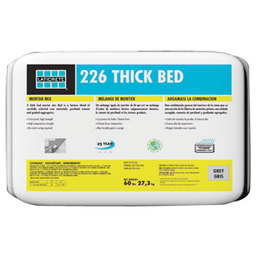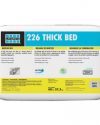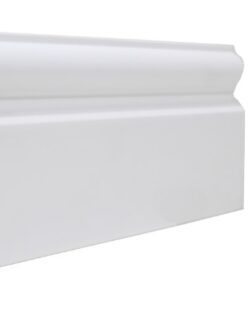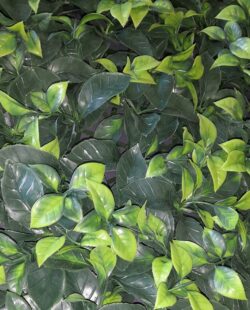No product in cart
226 Thick bed mortar
-
(0s)
- Add your review
PRODUCT DESCRIPTION LATICRETE 226 Thick Bed Mortar is a factory prepared blend of carefully selected raw materials, portland cement and graded aggregates. LATICRETE 226 Thick Bed Mortar was designed for use with LATICRETE 3701 Mortar Admix to produce a latex portland cement mortar that has exceptional strength. LATICRETE 3701 Fortified Mortar Bed is an […]
#Code Products:
Description
PRODUCT DESCRIPTION
LATICRETE 226 Thick Bed Mortar is a factory prepared blend of carefully selected raw materials, portland cement and graded aggregates. LATICRETE 226 Thick Bed Mortar was designed for use with LATICRETE 3701 Mortar Admix to produce a latex portland cement mortar that has exceptional strength. LATICRETE 3701 Fortified Mortar Bed is an approved substitute for LATICRETE 226 Thick Bed Mortar mixed with LATICRETE 3701 Mortar Admix.
Uses
For interior and exterior use for preparing conventional thick cement mortar beds, cement plasters, and concrete repairs.
Advantages
Premixed—No jobsite blending of powders required
Safe—Non-flammable; safe to store and mix
Economical—saves time and money
Easy to Use—no special tools required
Versatile—wet and dry areas, walls, floors, ceilings, interior and exterior
High Strength Formula
“Extra Heavy Service” rating per TCNA performance levels (RE: ASTM C627 Robinson Floor Test).
Suitable Substrates
(When mixed with LATICRETE 3701 Mortar Admix)
Concrete
Ceramic tile & stones
Concrete masonry
Brick masonry
Exterior glue plywood*
Cement mortar beds
Cement backer board**
Cement plaster
Cement terrazzo
* For interior only, minimum 2" (50 mm) over cleavage membrane with wire reinforcing.
** Consult cement backer board manufacturer for specific installation recommendations and to verify acceptability for exterior use.
Packaging
60 lbs (27.3 kg) bag; 56 bags per pallet
Shelf Life
Factory sealed containers of this product are guaranteed to be of first quality for one (1) year* if stored off the ground in a dry area.
* High humidity will reduce the shelf life of bagged product.
Limitations
Use LATAPOXY®300 Adhesive for installing green marble or water sensitive natural stone and agglomerates.
Adhesives/mastics, mortars and grouts for ceramic tile, pavers, brick and stone are not replacements for waterproofing membranes. When a waterproofing membrane is required, use a LATICRETE Waterproofing Membrane (see Section 10 FILING SYSTEMS).
Cautions
Consult MSDS for more information.
During cold weather, protect finished work from traffic until fully cured.
Contains portland cement and silica sand. May irritate eyes and skin. Avoid contact with eyes or prolonged contact with skin.
In case of contact, flush thoroughly with water.
Do not take internally. Silica sand may cause cancer or serious lung problems. Avoid breathing dust. Wear a respirator in dusty areas.
Keep out of reach of children.
INSTALLATION
Surface Preparation
All surfaces should be between 40°F (4°C) and 90°F (32°C) and structurally sound, clean and free of all dirt, oil, grease, laitance, paint, concrete sealers or curing compounds. Dry, dusty concrete slabs or masonry should be dampened and excess water swept off. Installation may be made on a damp surface. Expansion joints shall be provided through the tile work from all construction or expansion joints in the substrate. Follow ANSI specification A108.01–3.7 “Requirements for Movement Joints: Preparations by Other Trades” or TCNA detail EJ-171 “Movement Joints—Vertical & Horizontal”. Do not cover expansion joints with mortar.
Application
Mortar Bed
Mixing Mortar Bed—Dry Pack Consistency for floors Mix a 60 lb bag (27 kg) of LATICRETE 226 Thick Bed Mortar to 0.7 gal (2.7 ℓ) of LATICRETE 3701 Mortar Admix. Five (5) gallons (19 ℓ) of LATICRETE 3701 Mortar Admix mixes with approximately 7 bags of LATICRETE 226 Thick Bed Mortar, yielding approximately 45 ft2(4 m2 ) @ 1" (25 mm) thick. Mix to a stiff, semi-dry consistency (refer to bag for mixing hints). Mix ratio may vary dependent upon weight of finish.
Bonded Mortar Bed—Installation
Before placing mortar, apply a slurry bond coat made from LATICRETE 254 Platinum or LATICRETE 4237 Latex Additive mixed with LATICRETE 211 Powder. While the slurry bond coat is wet, spread the mortar and compact well. If placing tile immediately, apply a slurry bond coat, made from either LATICRETE 254 Platinum or LATICRETE 4237 Latex Additive mixed with LATICRETE 211 Powder to the mortar. While the slurry bond coat is wet and sticky, place the tile and beat in well. Refer to TDS 143 Slurry Bond Coats -When & What Use for more information on slurry bond coats.
Unbonded Mortar Bed—Installation
Before placing mortar, place a cleavage membrane (e.g. 4 mil thick polyethylene sheeting or 15 lb, builder felt) on the substrate. Place mortar over the cleavage membrane (approximately 1/2 the depth of the mortar bed). Next, place 2" x 2" (50 mm x 50 mm), 16 gauge galvanized welded wire mesh over the mortar. Then, place the balance of the mortar bed. The wire mesh should be suspended in the middle of the mortar bed. Spread the mortar and compact well.
Minimum mortar bed thickness shall be 2" (50 mm). If placing tile immediately, apply a slurry bond coat, made from either LATICRETE 254 Platinum or LATICRETE 4237 Latex Additive mixed with LATICRETE 211 Powder to the mortar. While the slurry bond coat is wet and sticky, place the tile and beat in well.
Application
Wall Renders
Mixing Wall Renders
Mix a 60 lb bag (27 kg) of LATICRETE 226 Thick Bed Mortar to 1 gal (3.8 ℓ) of LATICRETE 3701 Mortar Admix. Five (5) gallons (19 l) of LATICRETE 3701 Mortar Admix mixes with approximately 5 bags of LATICRETE 226 Thick Bed Mortar, yielding approximately 64 ft2(5.8 m2) @ 1/2" (12 mm) thick. Mix to a plastic consistency.
Wall Renders—Installation
No slurry bond coat is required prior to placing wall renders.
Apply wall render with a steel trowel pressing mortar into good contact with the substrate. Apply “scratch coat” first – not to exceed 1/2" (12 mm) thickness. Scratch mortar before it hardens. After “scratch coat” hardens, apply the “brown or float coat” working the mortar into good contact with the scratch coat. Do not exceed 5/8"(15 mm) thickness per lift. Scratch all lifts that will receive additional float coats. Float wall with steel trowel and straight edges to form a plumb and true mortar surface. Allow the completed render coats to cure for 24 hours at 70°F (21° C) prior to the installation of tile.
Application
Concrete Repair and Resurfacing—Leveling Mortar Consistency
Mixing Leveling Mortars
Mix a 60 lb bag (27 kg) of LATICRETE 226 Thick Bed Mortar to 1 gal(3.8 ℓ) of LATICRETE 3701 Mortar Admix. Five (5) gallons (19 l) of LATICRETE 3701 Mortar Admix mixes with approximately 5 bags of LATICRETE 226 Thick Bed Mortar, yielding approximately 64 ft2(5.8 m2) @ 1/2" (12 mm) thick. Mix to a plastic consistency. Mix ratio may vary dependent upon weight of finish.
Concrete Repair and Resurfacing— Installation
Before placing mortar, apply a slurry bond coat made from LATICRETE 254 Platinum or LATICRETE 4237 Latex Additive mixed with LATICRETE 211 Powder.
Apply a slurry bond coat to all reinforcing steel and existing clean, sound and stable concrete surfaces just prior to placing the mortar.
While the slurry bond coat is wet and sticky place the topping mortar. Compact the surface of the mortar with a flat trowel andensure all voids are filled. Avoid over troweling.
Note: A slurry bond coat should also be applied to the edges of mortar beds installed from previous work periods
Cold Weather Note: The setting of portland cement mortars and grouts are retarded by low temperatures. Protect finished work for an extended period when installing in cold weather.
Hot Weather Note: The evaporation of moisture in portland cement mortars is accelerated by hot, dry conditions. Apply mortar to dampened surfaces and protect freshly spread mortar and finished work when installing in temperatures over 90°F (32°C).
Cleaning
Clean tools and tile work with water while mortar is fresh.
You must be logged in to post a review.







Reviews
There are no reviews yet.